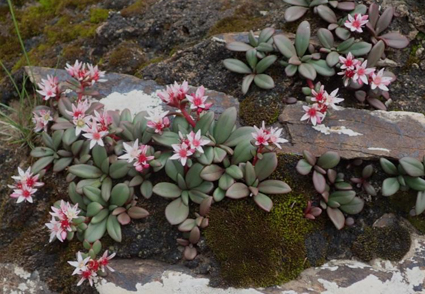Abstract
A new species from the Qinghai-Tibetan Plateau is described and illustrated. Rhodiola yushuensis S.Y. Meng et J. Zhang sp. nov. is similar to Rhodiola smithii (Hamet) S. H. Fu, but it differs in its inner caudex leaves with obvious petioles and the leaf blades are obovate-triangular (vs. inner caudex leaves with strongly descends to the base of the petiole, and the leaves are long linear) and the outer caudex leaves are scalelike, triangular-suborbicular (vs. scalelike, narrowly triangular). Principal component analysis (PCA) analysis of the leaf traits and seed coat architecture also showed that R. yushuensis can be separated from R. smithii. The nrDNA internal transcribed spacer (ITS) sequences also support the claim that this plant is a new species, and it is grouped with R. smithii.
References
Fu, S.H. & Fu, K.T. (1984) Crassulaceae. In: Chen, W.Q. & Ruan, Y.Z. (Eds.) Flora Reipublicae Popularis Sinicae. Science Press, Beijing, pp. 31–220.
Fu, K.T. & Ohba, H. (2001) Crassulaceae. In: Wu, C.Y. & Raven, P.H. (Eds.) Flora of China. Science Press, Beijing, pp. 202–268.
Guindon, S. & Gascuel, O. (2003) A simple, fast, and accurate algorithm to estimate large phylogenies by maximum likelihood. Systematic Biology 52: 696–704. https://doi.org/10.1080/10635150390235520
Hoang, D.T., Chernomor, O., von Haeseler, A., Minh, B.Q. & Vinh, L.S. (2018) UFBoot2: Improving the ultrafast bootstrap approximation. Molecular Biology and Evolution 35: 518–522. https://doi.org/10.1093/molbev/msx281
Kumar, S., Stecher, G. & Tamura, K. (2016) MEGA7: Molecular evolutionary genetics analysis version 7.0 for bigger datasets. Molecular Biology and Evolution 33: 1870–1874. https://doi.org/10.1093/molbev/msw054
Li, Z.H., Xiao, R., Pan, C.D., Jiang, D.A. & Wang, Q. (2016) Morphological characteristics, distribution, secondary metabolites and biological activities of Rhodiola L. Mini-Reviews in Organic Chemistry 13: 389–401. https://doi.org/10.2174/1570193X13666161017142011
Mayuzumi, S. & Ohba, H. (2004) The phylogenetic position of eastern Asian Sedoideae (Crassulaceae) inferred from chloroplast and nuclear DNA sequences. Systematic Botany 29: 587–598. https://doi.org/10.1600/0363644041744329
Miller, M.A. Pfeiffer, W. & Schwartz, T. (2010) Creating the CIPRES Science Gateway for inference of large phylogenetic trees. 2010 Gateway Computing Environments Workshop, New Orleans, pp. 1–8. https://doi.org/10.1109/GCE.2010.5676129
Nguyen, L.T., Schmidt, H.A., von Haeseler, A. & Minh, B.Q. (2015) IQ-TREE: a fast and effective stochastic algorithm for estimating maximum-likelihood phylogenies. Molecular Biology and Evolution 32: 268–274. https://doi.org/10.1093/molbev/msu300
Rohloff, J. (2002) Volatiles from rhizomes of Rhodiola rosea L. Phytochemistry 59: 655–661. https://doi.org/10.1016/s0031-9422(02)00004-3
Ronquist, F., Teslenko, M., van der Mark, P., Ayres, D.L., Darling, A., Höhna, S., Larget, B., Liu, L., Suchard, M.A. & Huelsenbeck, J.P. (2012) MrBayes 3.2: Efficient bayesian phylogenetic inference and model choice across a large model space. Systematic Biology 61: 539–542. https://doi.org/10.1093/sysbio/sys029
Rueden, C.T., Schindelin, J., Hiner, M.C., DeZonia, B.E., Walter, A.E., Arena, E.T. & Eliceiri, K.W. (2017) ImageJ2: ImageJ for the next generation of scientific image data. BMC Bioinformatics 18: 529. https://doi.org/10.1186/s12859-017-1934-z
Sharma, P. & Misra, K. (2018) Rhodiola sp.: The herbal remedy for high-altitude problems, In: Misra, K., Sharma, P. & Bhardwaj, A. (Eds.) Management of High-Altitude Pathophysiology. Academic Press, New York, pp. 81–92.
Sukumaran, J. & Mark, T.H. (2010) DendroPy: A Python library for phylogenetic computing. Bioinformatics 26: 1569–1571. https://doi.org/10.1093/bioinformatics/btq228
Thiede, J. & Eggli, U. (2007) Crassulaceae. In: Kubitzki, K. (Ed.) Flowering Plants · Eudicots. The Families and Genera of Vascular Plants. Springer, Heidelberg, pp. 83–118. https://doi.org/10.1007/978-3-540-32219-1_12
Wang, Z.M., Meng, S.Y. & Rao, G.Y. (2019) Quaternary climate change and habitat preference shaped the genetic differentiation and phylogeography of Rhodiola sect. prainia in the southern Qinghai-Tibetan Plateau. Ecology and Evolution 9: 8305–8319. https://doi.org/10.1002/ece3.5406
White, T.J., Bruns, T., Lee, S. & Taylor, J. (1990) Amplification and direct sequencing of fungal ribosomal RNA genes for phylogenetics. In: Innis, M., Gelfand, D., Sninsky, J. & White, T. (Eds.) PCR Protocols: A Guide to Methods and Applications. Academic Press, San Diego, pp. 315–322.
Zhang, J.Q., Meng, S.Y., Wen, J. & Rao, G.Y. (2014a) Phylogenetic relationships and character evolution of Rhodiola (Crassulaceae) based on nuclear ribosomal ITS and plastid trnL-F and psbA-trnH sequences. Systematic Botany 39: 441–451. https://doi.org/10.1600/036364414x680753.
Zhang, J.Q., Meng, S.Y., Allen, G.A., Wen, J. & Rao, G.Y. (2014b) Rapid radiation and dispersal out of the Qinghai-Tibetan Plateau of an alpine plant lineage Rhodiola (Crassulaceae). Molecular Phylogenetics and Evolution 77: 147–158. https://doi.org/10.1016/j.ympev.2014.04.013
Zhang, J.Q., Meng, S.Y. & Rao, G.Y. (2015) Two new species of Rhodiola (Crassulaceae) from the Qinghai-Tibetan Plateau. Phytotaxa 224: 159–172. https://doi.org/10.11646/phytotaxa.224.2.3


